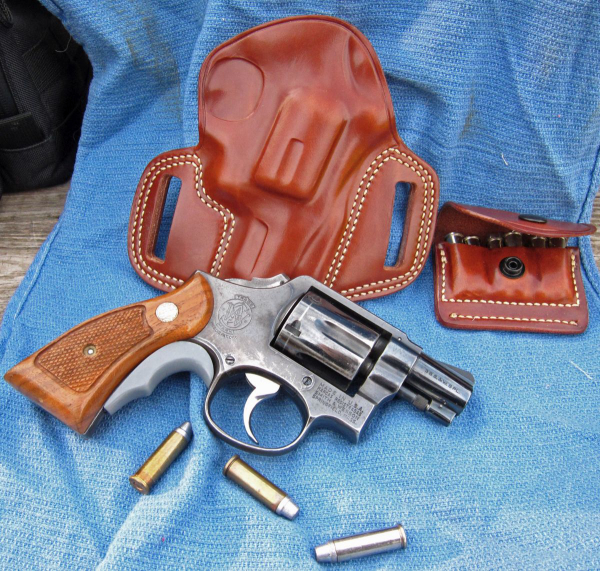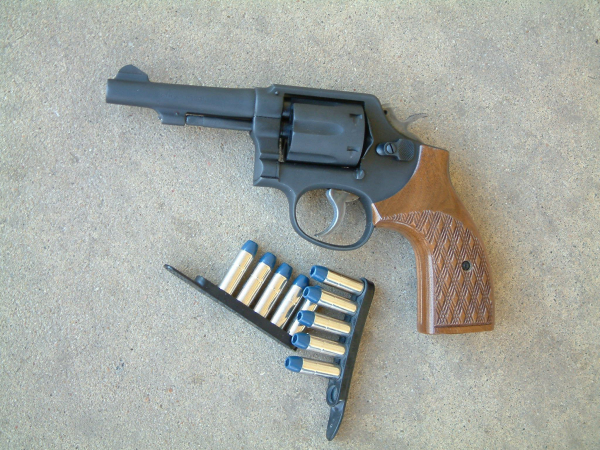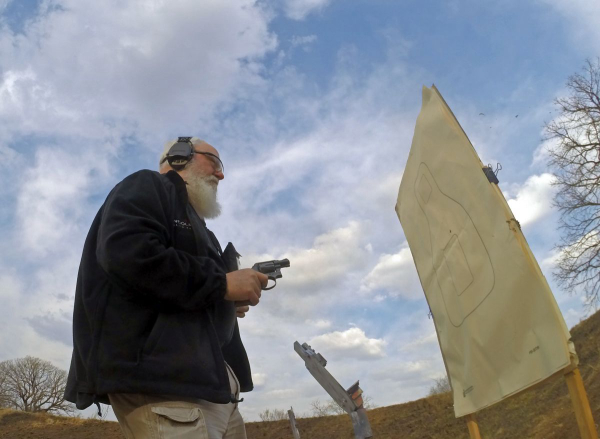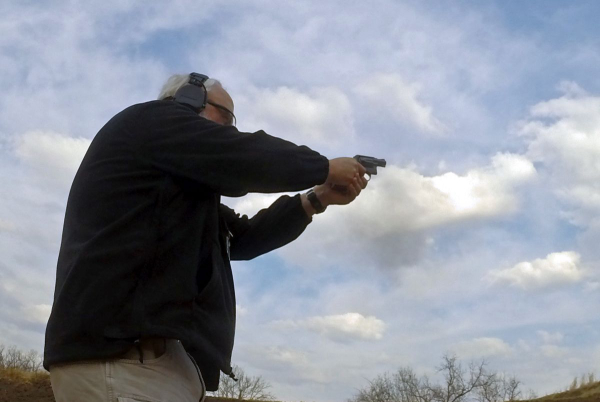
One of the most ordinary guns in existence, of which more than six million have been made in a variety of formats, is the Smith & Wesson Hand Ejector of 1899. It’s said, based on a short search, that the Army had a vast interest in the piece from its inception. Originally chambered in the “M1892 .38 U.S. Service Cartridge” – also known as the “38 Long Colt” – the new gun was affected by extant reports of the so-called failure of that cartridge in the Philippines. For that reason, it was chambered, in that first year, for the upsized, “more powerful” 38 S&W Special cartridge.
Renamed the “Military & Police Model,” a star was born. Humdrum hardware, or so it became as gussied up guns attained favor from just before WWII through the end of that new century, it’s a solid, swing-out cylinder “all you really need” handgun. The front sight changed appearance and function, as the rear notch cut along the top strap to accommodate – but the M&P was still the M&P until Smith & Wesson adopted the model-number convention in the 1950s. The standard gun became the Model 10.

With an aluminum alloy frame, it became the Model 12. The steel frame gun with a slightly longer cylinder in 357 Magnum became the Model 13. The variant with adjustable sights and some other upgrades was the Combat Masterpiece (Model 15), itself a shortened version of the K-38 Target Masterpiece Model 14.
The Model 10 was issued in five- and six-inch versions, as well as the later, more common 4” trim. It was also available in a 2” snub version, with either round or square butt.
I’ve had an affinity for the square butt guns since I don’t have to do police work anymore. Nostalgia more than anything, I remember looking with derision upon the chief investigator for my first police agency. An older gent who moon-lighted throwing newspapers, he wore a two-inch M10 SB in a cross-draw holster.
I couldn’t imagine the use of such a thing, until I saw our evening watch commander clean the qual course with a two-inch Combat Masterpiece, also with a square butt. I later copied our chief of police by wearing an analog of his Model 36 Chiefs Special 3” heavy barrel square butt. It looked like someone had left a standard Model 10 in the clothes drier long enough that it shrank … and it shot like a house afire.
While a number of guns came and went during my checkered guncrank lifestyle, a two-inch square butt Model 10 never did – until recently.
Kind of a ‘well-worn’ example, it left the factory in late 1974 to early 1975. The serial number is engraved on the left side of the top strap above the cylinder in addition to the standard locations as the gun had been shipped to France, likely for some police duty. The gun had likely been a four-inch. The user or armorer decided it needed a more visible front sight, so they attempted to drill the barrel for a screw to mount a new front sight … drilling through the barrel wall and into the bore.
This is why we can’t have nice things.
A friend got the gun for a song. He had a two-inch M10 barrel, found a matching extractor rod and put the mess together. He rounded and smoothed the face of the trigger and dehorned the hammer. After adding a grip adapter under the standard S&W Magna stocks, he called it quits. When he found out I was enamored of that type of roscoe, he gifted it to me.
I couldn’t have been happier with anything.


I added a Galco Combat Master holster and their 2x2x2 ammo carrier so I could figure out if I could use the large snub.
The two-inch K-revolver was seen by many of my era – including me – as a waste of steel. The various J-38s of my era were far better for concealment, the province of the snub, and only held one round down. While you couldn’t finesse the coil-spring J-frame as you could the appropriately marketed “Masterpiece” that was the K-frame S&W action, that seldom mattered; the small short guns were more accurate than most of us could hold anyway.
But what about shooting the new-to-me snub? That took a range trip.
As we’d had a variety of issues, from weather events to various life interference, it took some time to get out there. In deference to the recent ammo famine, I devised a short course to evaluate guns. While it doesn’t reveal everything, it gives us enough information to reach some conclusions.
First, the refitted Model 10 hits high. At least some of that is the result of 20 years of shooting “plastic fantastic.” In other words, it’s the shooter’s lack of familiarity. Part of that is a short grip adapter. The other is the fit of the S&W Magna stocks: after more than six million copies, there’s enough frame variation – as well as the variation in individual stocks, that this pair leaves some steel exposed at the top. The allows the gun to squirm in recoil, hammering the proximal joint of the thumb.
Ever try to find so-called “boot grips” for the square-butt K-frame revolver?
I used remanufactured ammo from the 1990s and shot the 25 round short course. The target is the FBI-QIT 99. The stages follow:
1.5 yards: Arm’s reach, the gun is fired as it comes level onto the target. The first string is a single, the second a pair.
3 yards: One hit, to head box, one-handed.
5 yards: One hit, to head box, two-handed.
7 yards: Failure drill: a pair ‘high chest,’ single to the head.
10 yards: Pair
15 yards: A pair. Then singles from low ready (X2).
25 yards: Five round string, followed by a six-round string.
That totals 25 rounds. I count four points per (relevant) hit to get a percentage. It’s not as comprehensive as the comparative standards and it’s less data-intensive. That makes it quicker to do and report, but doesn’t give the information.
With the S&W M10-6, I counted one down for 96%. All hits were in the silhouette – but the gun and I used up a lot of the target.
What next? Well, figure out the interface solution – appropriate stocks – then do something about the visibility of the front sight. The action is heavy, but not horribly so. I’ll just practice to deal with that. I’m still interested in exploring the Myres “suspenders” holster reissue idea I’ve been kicking around with a few people.
But, mostly, I just intend to enjoy the old blaster. I don’t care if I ever carry it.
I’ll just be grateful it’s here and thankful for friends like the one who made this gift.
-- Rich Grassi